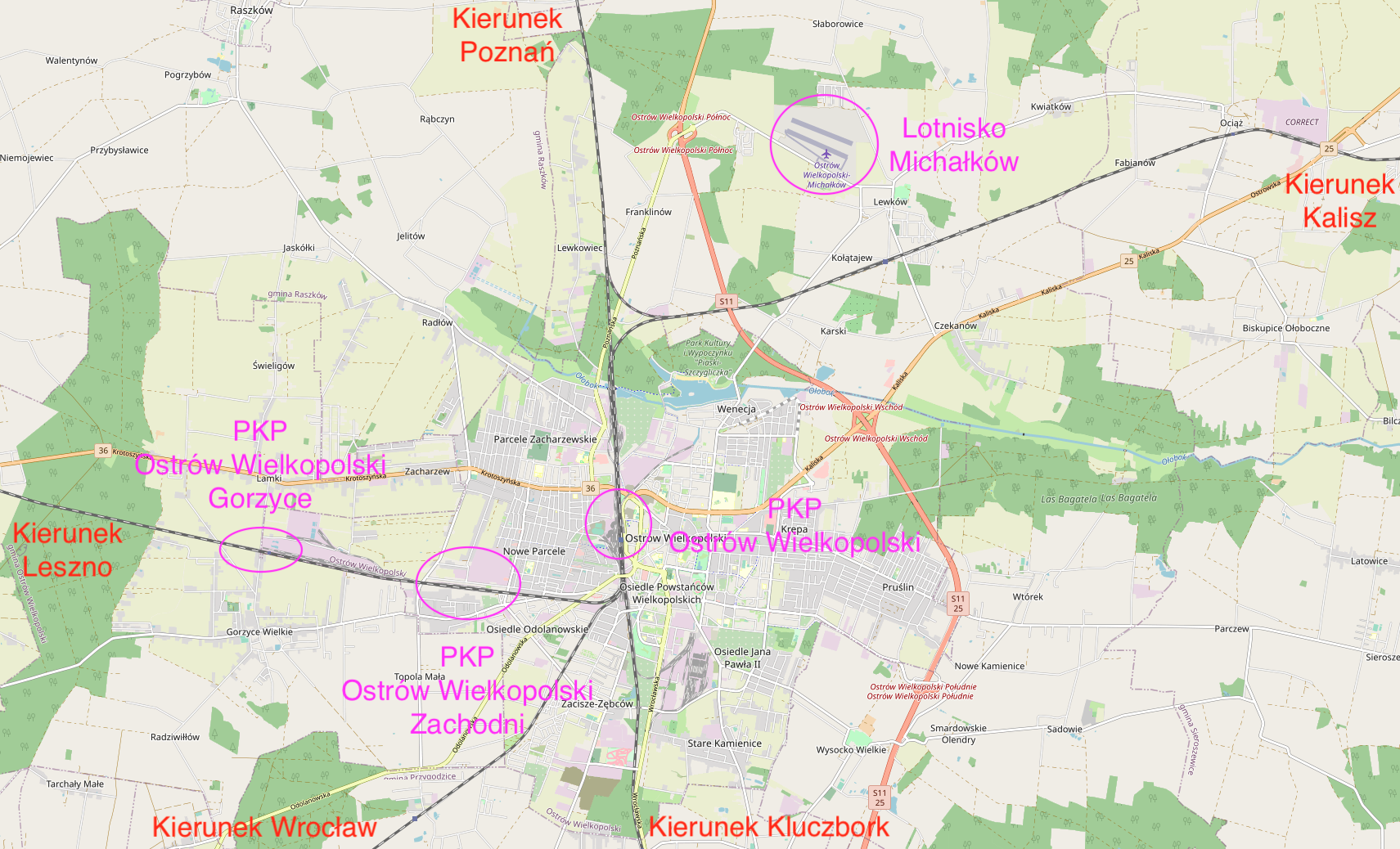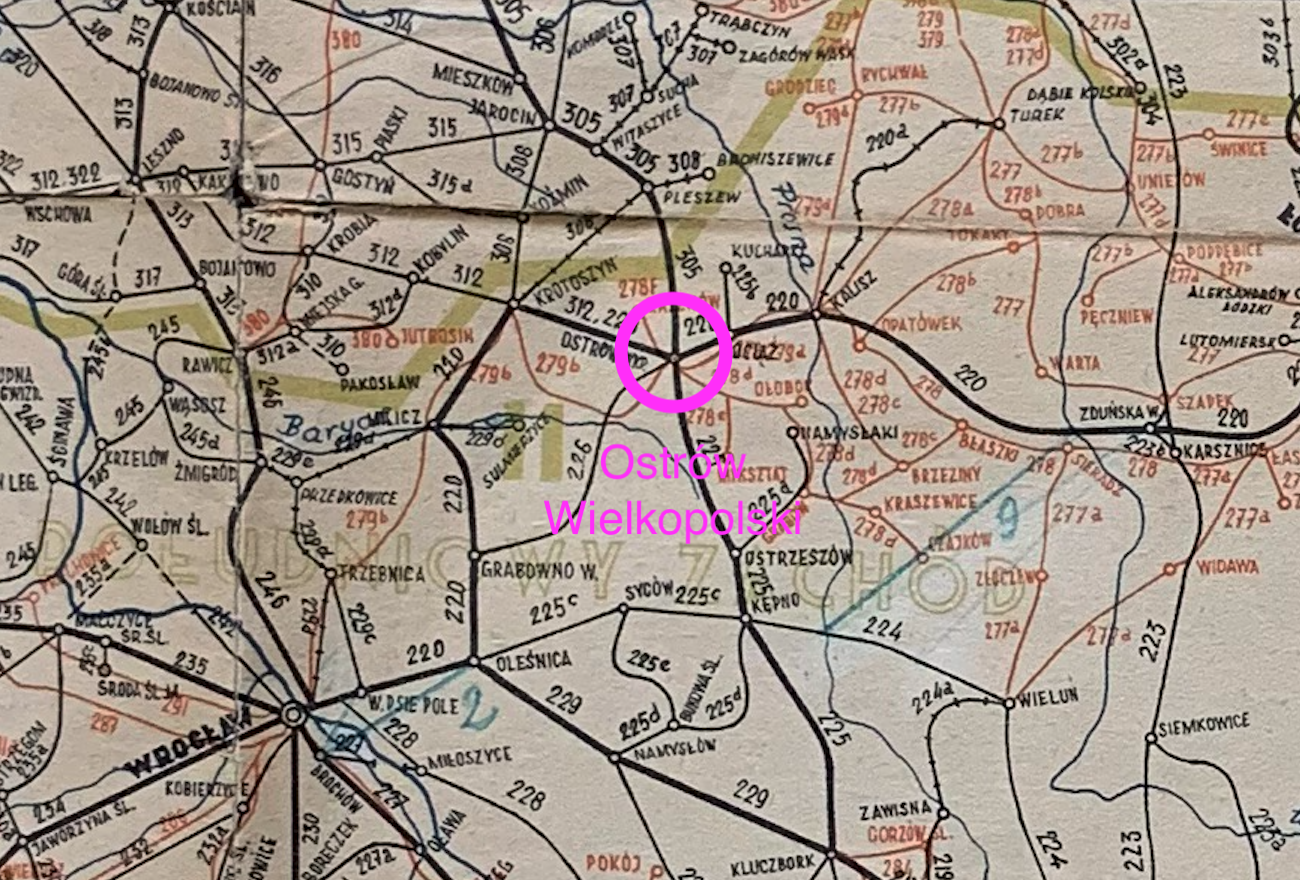Ostrów Wielkopolski 2022-12-28
The city of Ostrow Wielkopolski.
Ostrów Wielkopolski is a city in Wielkopolska, in the Wielkopolskie Voivodship. The city has an area of 41.90 km2. In 2020, Ostrów Wielkopolski had 71,560 inhabitants and the city was ranked 53rd among the most populous cities in Poland. The city received city rights in 1404 and they were confirmed in 1713. The patron saint of the city is St. Stanisław from Szczepanów.
The town was called Ostrów, and then Ostrów Kaliski (1919-1920). The name Ostrów Wielkopolski was given in 1920, when Wielkopolska returned to Poland. Ostrów Wielkopolski is located close to Kalisz, just 25 km away. From Ostrów Wielkopolski to: Poznań is 120 km, Wrocław is 100 km, Warsaw is 275 km, Krakow is 310 km.
Geographically, Ostrów Wielkopolski is located in the South Greater Poland Lowland. Traces of the settlement of Ostrów Wielkopolski date back to the 11th century. In the fifteenth century, the stronghold had city rights, but as a result of numerous wars and fires, the stronghold fell into decline. Thanks to the efforts of Jan Jerzy Przebendowski, in 1713, Ostrów again received city rights under the Magdeburg law, combined with the issuance of numerous royal privileges. The vicinity of the city is one of the main natural gas extraction areas in Poland.
PKP Ostrow Wielkopolski.
Geographic coordinates 51.649N 17.805E.


The railway became an impulse for the development of the village. Around 1870, the Poznań-Kluchborska company was founded, with the German name Posen - Kreuzburger Eisenbahn, PKE. The seat of the company was in Poznań, and the company had only one line: Poznań - Jarocin - Ostrów Wielkopolski - Ostrzeszów - Kępno - Kluczbork. In Poznań, a new bridge was built across the Warta River, which is currently (2022) called Most Dębiński. The trail was 200.9 km long and was launched on December 10, 1875. Initially, there was only one track. A second track was added in 1899. The company was nationalized in 1884. Due to the route of the route near the border of the Russian and German partitions, the line was important in the exchange of people and goods. Nowe Skalmierzyce was the border station on the German side, and Kalisz Szczypiorno on the Russian side.
Ostrów Wielkopolski quickly became a junction station in five directions: Poznań, Kluczbork, Leszno (1888), Kalisz (1896 and then Łódź), Oleśnica (1909 and further Wrocław). In the period 1906 - 1922, trains from Warsaw to Poznań ran through the Ostrów Wielkopolski junction, and from 1910, Warsaw-Wrocław.
In November 1918, the native inhabitants of Ostrów Wielkopolski (Poles) took power from the Germans bloodlessly and the Republic of Ostrow was established. The city and its surroundings became part of Poland. In 1918, when Poland regained its independence, the Poznań - Kluczbork line was divided between Poland and Germany. On the Polish side, the border station was Lęka Opatowska, and on the German side, Kostów. In 1919, echelons of the "Blue Army" passed through Ostrów Wielkopolski.
In 1920, the foundation stone for a new factory was laid in Ostrów Wielkopolski. In 1921, the metal and machinery plant "Fabryka Wagonów" was launched as part of the concern Polskie Fabryki Maszyn i Wagonów L. Zieleniewski S.A. The first new wagons were built in the second half of 1921. In the second, new hall, the carriages were renovated. The next investments were the construction of a power station, a locomotive shed, a sawmill, and management buildings. In 1927, the factory was taken over by the state. In 1929, the Railway Workshops in Skalmierzyce were attached to the factory. During the German occupation, the plant repaired wagons, and after World War II, in 1945, the plant was nationalized. In 1950, the Mechanical Workshops of the State Railways No. 11 were established. In 1952, the factory was incorporated into the structures of PKP and the "Ostrów" Rolling Stock Repair Plant was established. In 1961, the Centralne Biuro Konstrucyjne Wagonów was established in the plant. In the following years, a heat and power plant, a forge and a foundry were built. In 1999, the plant received the name "Fabryka Wagonów". Since 2010, the factory has a new owner and further changes in ownership and the range of products were carried out. (Polish Rolling Stock Sp. z o.o.).
In 1945, the entire Poznań - Kluczbork route was incorporated into Poland and received No. 272. The electrification of the route took place in 1973-1974. Currently (2022) there are three railway stations within the city limits: Ostrów Wielkopolski (passenger and freight), Ostrów Wielkopolski Gorzyce (passenger stop), Ostrów Wielkopolski Zachodni (freight station).
Ostrow Wielkopolski railway station.
The station was opened on December 10, 1875. Also in 1875, the station building was opened, which was completely rebuilt in 1966. The station building is located in the eastern part of the station plain. In 1966, the station was completely rebuilt and significantly enlarged. Inside, waiting rooms, a restaurant, toilets, ticket offices, luggage storage and railway service rooms were built. The volume of the building is 11,200 m3. The neighboring buildings, built of half-timbered walls, were demolished. A new building was built, in which a railway canteen and a night shelter were placed. A new building of the Polish Post Office was built.
In 1966, during the renovation of the station, the tunnel for travelers under the platforms and the platforms themselves with their shelters were renovated. In 2016, another renovation of platforms and platform shelters was carried out. The tunnel has also been renovated. New lighting, a railway information system were installed and the street furniture was changed. The square in front of the station was completely rebuilt and its communication layout was changed. New lighting has been installed.
Platform 1 is located at the station and has a single edge. The platform is 295 m long. The platform has a roof over the length of the entire station building. Platform 2 is an island platform and has two edges. The platform is 280 m long. There is a 115 m long roof on the platform. Platform 3 is an island platform and has two edges. The platform is 280 m long. There is a 115 m long roof on the platform.
Two fan-type locomotive sheds were erected on the western side of the station plain. Turntables were installed in front of each locomotive depot. There were also coal entanglements and other railway buildings. The water tower at the station dates from 1912 and is currently not in use. Two steam locomotives stand as monuments at the station. There is a Ty45 and a TKi3 locomotive.
In 2018, the station served up to 3,800 passengers.
Railway lines.
Railway line No. 272 Kluczbork - Poznań Główny. The line was electrified in 1973 - 1974. The railway line No. 14 Łódź Kaliska - Tuplice is 388.578 km long. The line runs south. The line belongs to freight corridor No. 8. The entire length of the line is equipped with the SHP system. The railway line No. 355 Ostrów Wielkopolski - Grabowno Wielkie (Oleśnica, Wrocław) is 53 km long. The line is single track and electrified.
In 1987, the electrification of the last line from Ostrów Wielkopolski was completed. At that time, the last shape semaphores were replaced with light ones.
Wielkopolanie train.
In the 1970s and 1980s, the popular express train "Wielkopolani" ran through Ostrów Wielkopolski. The train was initially Poznań - Katowice, and then (1970) an extended route to Kraków. Since not the entire route was electrified yet, part of the route was covered by the train with the SU45 diesel locomotive. Periodically, the train was referred to as the Express. The train from Poznań departed at 06:00 and reported to Kraków at 12:00, having traveled 399 km. The commercial speed was 66.5 km/h. The train stopped at the following stations: Środa Wielkopolska, Jarocin, Ostrów Wielkopolski, Kępno, Kluczbork, Lubliniec, Tarnowskie Góry, Bytom, Chorzów Stary, Chorzów Miasto, Chorzów Batory (currently 2022, there are no passenger trains on the section Bytom - Chorzów Batory), Katowice, Mysłowice, Jaworzno Szczakowa, Trzebinia, Krzeszowice, Krakow. On the way back from Krakow, the train started at 16:00 and arrived in Poznań at 22:00. The train consisted of 6-8 cars. One 1st Class car and a WARS buffet car, half of the car being 2nd Class compartments and the rest a buffet with bar-type tables. "Wielkopolanin" was one of the first trains in PKP with reservation of seats. Seats at the price of PLN 10 could be purchased only at the starting station. At intermediate stations, passengers took free seats and bought a seat from the conductor.
PKP Ostrow Wielkopolski Gorzyce.
The passenger stop Ostrów Wielkopolski Gorzyce is located on line No. 14 Łódź Kaliska - Tuplice, in the western part of the city. There is one island platform with two edges at the stop.
PKP Ostrów Wielkopolski Zachodni.
The Ostrów Wielkopolski Zachodni railway station was opened in 1955, at the time of increased freight transport to lift the war-ruined country. The station is also located on the No. 14 Łódź Kaliska - Tuplice railway line, but closer to the city center. The station provides services to the surrounding workplaces.
PKP Ostrów Wielkopolski currently.
Currently, 76 passenger trains leave the Ostrów Wielkopolski station daily. With this result, the station breaks all previous records in history. From Ostrów Wielkopolski you can go to: Białystok InterCity "Dąbrowska". Ełk InterCity "Słowacki". Kalisz Greater Poland Railways. Katowice TLK "Spodek". Kępno 7 connections operated by Koleje Wielkopolskie and PolRegio. Kluczbork 3 connections served by PolRegio. Kołobrzeg InterCity "Zefir" or "Zamoyski". Kraków Główny 4 InterCity connections "Wybicki", "Osterwa", "Zefir" or "Zamoyski" and TLK "Pułaski". Leszno 6 connections operated by Koleje Wielkopolskie. Lublin Główny 5 InterCity “Konopnicka” connections, 3 PolRegio trains and 1 Koleje Wielkopolskie train. Lodz Kaliska. Odolanów 3 trains of Koleje Wielkopolskie. Poznań Główny 21 trains, including InterCity, TLK, PolRegio, Koleje Wielkopolskie. Szczecin Główny InterCity "Podhalanin" and InterCity "Osterwa". Warsaw Gdansk InterCity "Asnyk". Warszawa Główna 3 PolRegio trains. Warszawa Wschodnia 2 InterCity trains "Łużyce" and "Baczyński". Wrocław Główny 11 InterCity and PolRegio trains. Zakopane InterCity "Podhalanin". Zgorzelec InterCity "Łużyce".
Written by Karol Placha Hetman
